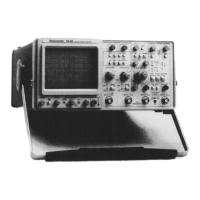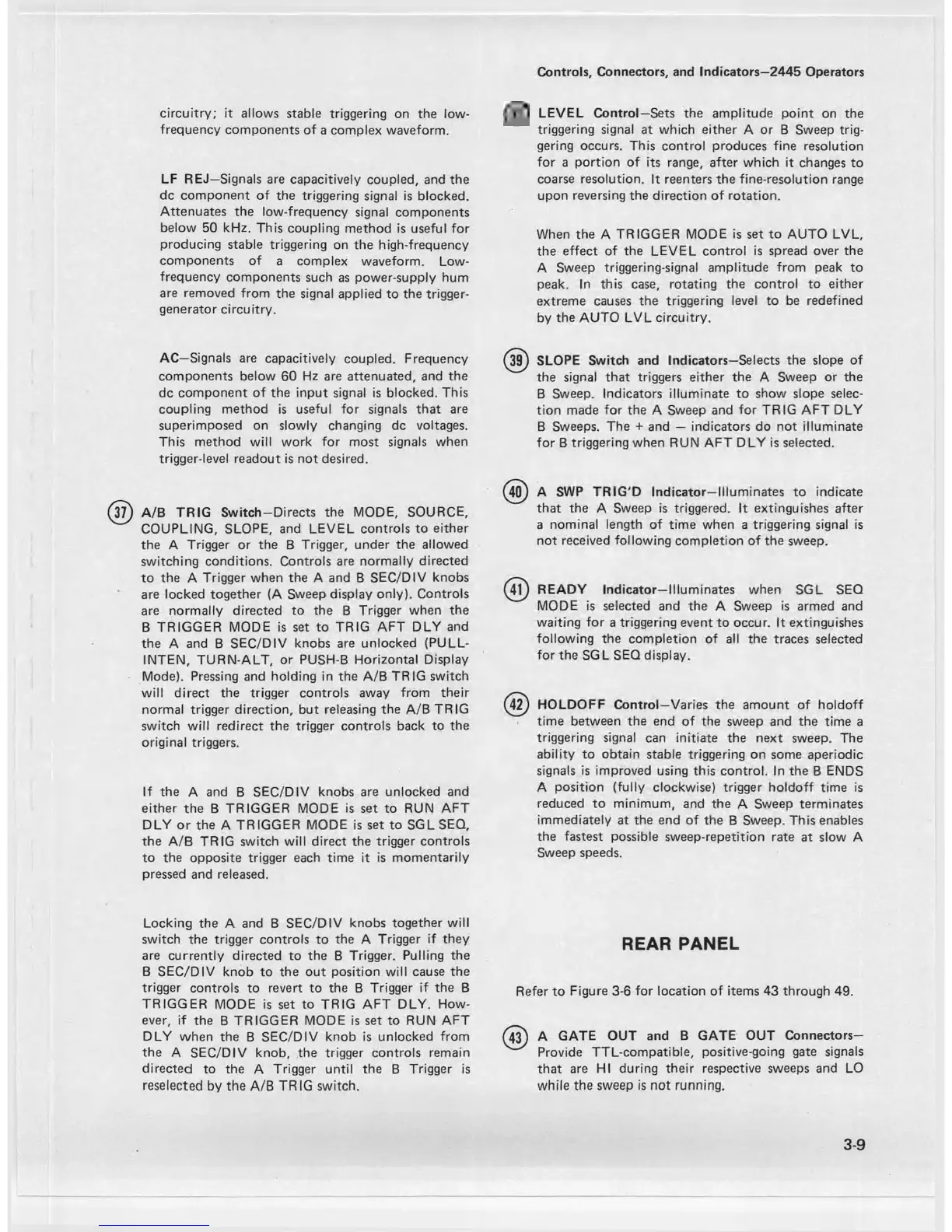Controls, Connectors, and Indicators—2445 Operators
circuitry; it allows stable triggering on the low-
frequency components of a complex waveform.
LF REJ—Signals are capacitively coupled, and the
dc component of the triggering signal is blocked.
Attenuates the low-frequency signal components
below 50 kHz. This coupling method is useful for
producing stable triggering on the high-frequency
components of a complex waveform. Low-
frequency components such as power-supply hum
are removed from the signal applied to the trigger-
generator circuitry.
AC—Signals are capacitively coupled. Frequency
components below 60 Hz are attenuated, and the
dc component of the input signal is blocked. This
coupling method is useful for signals that are
superimposed on slowly changing dc voltages.
This method will work for most signals when
trigger-level readout is not desired.
(37) A/B TRIG Switch-Directs the MODE, SOURCE,
COUPLING, SLOPE, and LEVEL controls to either
the A Trigger or the B Trigger, under the allowed
switching conditions. Controls are normally directed
to the A Trigger when the A and B SEC/DIV knobs
are locked together (A Sweep display only). Controls
are normally directed to the B Trigger when the
B TRIGGER MODE is set to TRIG AFT DLY and
the A and B SEC/DIV knobs are unlocked (PULL-
INTEN, TURN-ALT, or PUSH-B Horizontal Display
Mode). Pressing and holding in the A/B TRIG switch
will direct the trigger controls away from their
normal trigger direction, but releasing the A/B TRIG
switch will redirect the trigger controls back to the
original triggers.
If the A and B SEC/DIV knobs are unlocked and
either the B TRIGGER MODE is set to RUN AFT
DLY or the A TRIGGER MODE is set to SGL SEQ,
the A/B TRIG switch will direct the trigger controls
to the opposite trigger each time it is momentarily
pressed and released.
Locking the A and B SEC/DIV knobs together will
switch the trigger controls to the A Trigger if they
are currently directed to the B Trigger. Pulling the
B SEC/DIV knob to the out position will cause the
trigger controls to revert to the B Trigger if the B
TRIGGER MODE is set to TRIG AFT DLY. How
ever, if the B TRIGGER MODE is set to RUN AFT
DLY when the B SEC/DIV knob is unlocked from
the A SEC/DIV knob, the trigger controls remain
directed to the A Trigger until the B Trigger is
reselected by the A/B TRIG switch.
LEVEL Control—Sets the amplitude point on the
triggering signal at which either A or B Sweep trig
gering occurs. This control produces fine resolution
for a portion of its range, after which it changes to
coarse resolution. It reenters the fine-resolution range
upon reversing the direction of rotation.
When the A TRIGGER MODE is set to AUTO LVL,
the effect of the LEVEL control is spread over the
A Sweep triggering-signal amplitude from peak to
peak. In this case, rotating the control to either
extreme causes the triggering level to be redefined
by the AUTO LVL circuitry.
(39) SLOPE Switch and Indicators—Selects the slope of
the signal that triggers either the A Sweep or the
B Sweep. Indicators illuminate to show slope selec
tion made for the A Sweep and for TRIG AFT DLY
B Sweeps. The + and — indicators do not illuminate
for B triggering when RUN AFT DLY is selected.
(
40
) A SWP TRIG'D Indicator—Illuminates to indicate
that the A Sweep is triggered. It extinguishes after
a nominal length of time when a triggering signal is
not received following completion of the sweep.
(
4
?) READY Indicator—Illuminates when SGL SEQ
MODE is selected and the A Sweep is armed and
waiting for a triggering event to occur. It extinguishes
following the completion of all the traces selected
for the SG L SEQ display.
(
42
) HOLDOFF Control—Varies the amount of holdoff
time between the end of the sweep and the time a
triggering signal can initiate the next sweep. The
ability to obtain stable triggering on some aperiodic
signals is improved using this control. In the B ENDS
A position (fully clockwise) trigger holdoff time is
reduced to minimum, and the A Sweep terminates
immediately at the end of the B Sweep. This enables
the fastest possible sweep-repetition rate at slow A
Sweep speeds.
REAR PANEL
Refer to Figure 3-6 for location of items 43 through 49.
(
43
) A GATE OUT and B GATE OUT Connectors—
Provide TTL-compatible, positive-going gate signals
that are HI during their respective sweeps and LO
while the sweep is not running.
3-9

